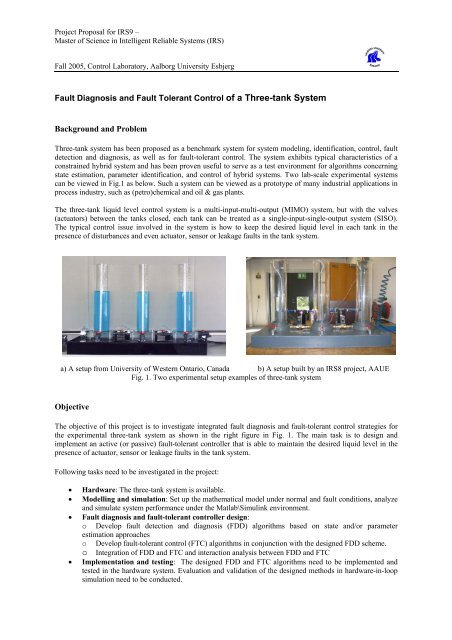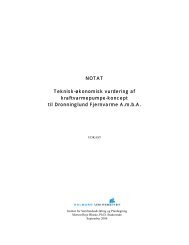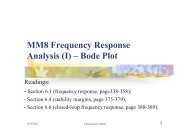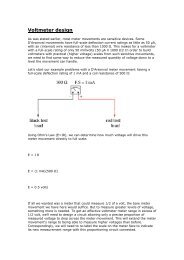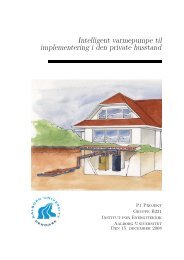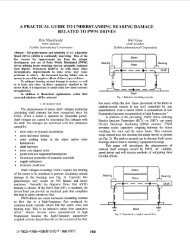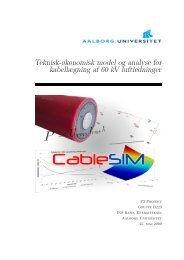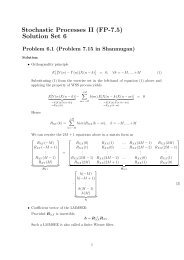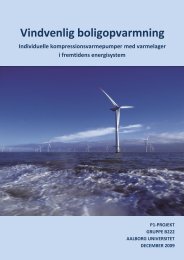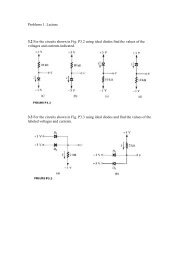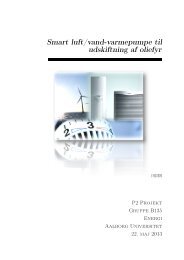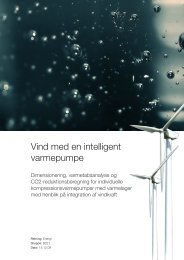Control of an Inverted Pendulum
Control of an Inverted Pendulum
Control of an Inverted Pendulum
Create successful ePaper yourself
Turn your PDF publications into a flip-book with our unique Google optimized e-Paper software.
Project Proposal for IRS9 –Master <strong>of</strong> Science in Intelligent Reliable Systems (IRS)Fall 2005, <strong>Control</strong> Laboratory, Aalborg University EsbjergFault Diagnosis <strong>an</strong>d Fault Toler<strong>an</strong>t <strong>Control</strong> <strong>of</strong> a Three-t<strong>an</strong>k SystemBackground <strong>an</strong>d ProblemThree-t<strong>an</strong>k system has been proposed as a benchmark system for system modeling, identification, control, faultdetection <strong>an</strong>d diagnosis, as well as for fault-toler<strong>an</strong>t control. The system exhibits typical characteristics <strong>of</strong> aconstrained hybrid system <strong>an</strong>d has been proven useful to serve as a test environment for algorithms concerningstate estimation, parameter identification, <strong>an</strong>d control <strong>of</strong> hybrid systems. Two lab-scale experimental systemsc<strong>an</strong> be viewed in Fig.1 as below. Such a system c<strong>an</strong> be viewed as a prototype <strong>of</strong> m<strong>an</strong>y industrial applications inprocess industry, such as (petro)chemical <strong>an</strong>d oil & gas pl<strong>an</strong>ts.The three-t<strong>an</strong>k liquid level control system is a multi-input-multi-output (MIMO) system, but with the valves(actuators) between the t<strong>an</strong>ks closed, each t<strong>an</strong>k c<strong>an</strong> be treated as a single-input-single-output system (SISO).The typical control issue involved in the system is how to keep the desired liquid level in each t<strong>an</strong>k in thepresence <strong>of</strong> disturb<strong>an</strong>ces <strong>an</strong>d even actuator, sensor or leakage faults in the t<strong>an</strong>k system.a) A setup from University <strong>of</strong> Western Ontario, C<strong>an</strong>ada b) A setup built by <strong>an</strong> IRS8 project, AAUEFig. 1. Two experimental setup examples <strong>of</strong> three-t<strong>an</strong>k systemObjectiveThe objective <strong>of</strong> this project is to investigate integrated fault diagnosis <strong>an</strong>d fault-toler<strong>an</strong>t control strategies forthe experimental three-t<strong>an</strong>k system as shown in the right figure in Fig. 1. The main task is to design <strong>an</strong>dimplement <strong>an</strong> active (or passive) fault-toler<strong>an</strong>t controller that is able to maintain the desired liquid level in thepresence <strong>of</strong> actuator, sensor or leakage faults in the t<strong>an</strong>k system.Following tasks need to be investigated in the project:• Hardware: The three-t<strong>an</strong>k system is available.• Modelling <strong>an</strong>d simulation: Set up the mathematical model under normal <strong>an</strong>d fault conditions, <strong>an</strong>alyze<strong>an</strong>d simulate system perform<strong>an</strong>ce under the Matlab\Simulink environment.• Fault diagnosis <strong>an</strong>d fault-toler<strong>an</strong>t controller design:o Develop fault detection <strong>an</strong>d diagnosis (FDD) algorithms based on state <strong>an</strong>d/or parameterestimation approacheso Develop fault-toler<strong>an</strong>t control (FTC) algorithms in conjunction with the designed FDD scheme.o Integration <strong>of</strong> FDD <strong>an</strong>d FTC <strong>an</strong>d interaction <strong>an</strong>alysis between FDD <strong>an</strong>d FTC• Implementation <strong>an</strong>d testing: The designed FDD <strong>an</strong>d FTC algorithms need to be implemented <strong>an</strong>dtested in the hardware system. Evaluation <strong>an</strong>d validation <strong>of</strong> the designed methods in hardware-in-loopsimulation need to be conducted.
Project Proposal for IRS9 –Master <strong>of</strong> Science in Intelligent Reliable Systems (IRS)Fall 2005, <strong>Control</strong> Laboratory, Aalborg University EsbjergReferences:1.2.3.4.5.DE8-F05-4 project report, FDD for the three-t<strong>an</strong>k system, AAUE, Spring 2005.D. Mignone <strong>an</strong>d N. Monachino, The Total Three T<strong>an</strong>k Tutorial Text, Technical Report, ETH Zurich,2001.B. Heiming <strong>an</strong>d J. Lunze. Definition <strong>of</strong> the Three-T<strong>an</strong>k Benchmark Problem for <strong>Control</strong>lerReconfiguration, Proceedings <strong>of</strong> the Europe<strong>an</strong> <strong>Control</strong> Conference, Karlsruhe, Germ<strong>an</strong>y, 1999.J-C. Ponsart, D. Theilliol <strong>an</strong>d H. Noura, Fault-toler<strong>an</strong>t control method for actuator <strong>an</strong>d componentfaults applied to a hydraulic system, Proc. <strong>of</strong> the Europe<strong>an</strong> <strong>Control</strong> Conference 2001, pp. 1044-1049.J-C. Ponsart, C. Join, D. Theilliol <strong>an</strong>d D. Sauter, Sensor fault diagnosis <strong>an</strong>d accommodation innonlinear system, Proc. <strong>of</strong> the Europe<strong>an</strong> <strong>Control</strong> Conference 2001, pp. 2346-2351.Key words: Fault detection <strong>an</strong>d diagnosis (FDD), fault toler<strong>an</strong>t control (FTC); PID (Proportional-Integral-Derivative) control, state-space model-based reconfigurable control.RemarksThis project is <strong>an</strong> extension <strong>an</strong>d continuation <strong>of</strong> <strong>an</strong> IRS8 project investigated in Fall 2004, as shown in reference[1]. The emphasis <strong>of</strong> this project is to investigate mainly for active fault toler<strong>an</strong>t control (FTC), i.e., integratedFDD <strong>an</strong>d FTC.Proposer: Youmin Zh<strong>an</strong>g, FUV 0.22; Phone: 7912 7741Email: ymzh<strong>an</strong>g@cs.aaue.dk; URL: http://www.cs.aue.auc.dk/~ymzh<strong>an</strong>g/


